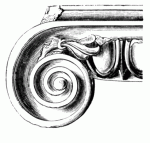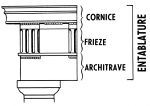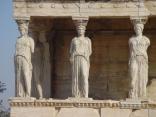Period: Greek
Dates: 2000 BCE – 30 BCE
~Elegance ~Precision ~Innovation
Greece around 2000 around BCE was a group of city states (1), which all had their own government and political systems. The economy was stimulated by trade. There was not a lot of agricultural activity. Mountainous terrain, other geographical obstacles, and conflict prevented the city states from uniting. This eventually became their downfall, when the powers of the Roman empire conquered them.
Greek architecture is known for its temples, theatres, and public forums. Three orders of architecture were brought to life during this period: Doric, Ionic, and Corinthian (2).
The corresponding column styles exist of three parts: the base, the middle (or the shaft), and the capital.
The Doric column does not have a base due to its simple design characteristics. Both the Ionic and the Corinthian columns have bases. Like the other column styles, the Doric column has fluting (3), or vertical engraving in the shaft. The Ionic columns have large scrolls engraved in the capitals. Those are called volutes (4).
The Corinthian columns are the most decorative. The capitals are decorated with acanthus leaves (5). The type of capital dictates the order name.

On top of the capitals the Greek built entablatures (6). These entablatures consist of three parts: the architrave sits on top of the capital. The second part is the frieze, which is a decorated border with carvings of lettering. Occassionally friezes are plain. Lastly we find the cornice, which is a series of decorative moldings.
A lot of the buildings in the Acropolis (7) (meaning: the fortified height or citadel of an ancient Greek city) area of Athens had these characteristics. Some of the buildings in the Acropolis are the Parthenon, The Erechteion (8), and the Temple of Athena Nike. The Parthenon is dedicated to the goddess Athena. It has Doric columns and coffered ceilings. The Erechteion is dedicated to Poseidon and Zeus. It has a tomb of the founder of Athens. The Erechteion has Ionic columns and caryatids (9). Caryatids are columns consisting of female shapes as the shaft of the columns.
Greek furniture of the period was simple and elegant. No authentic wood pieces are around today, since the Greek burned everything you owned when you died.
Thanks for reading my blog. Hope you liked it! Any feedback or additional info is welcome.







